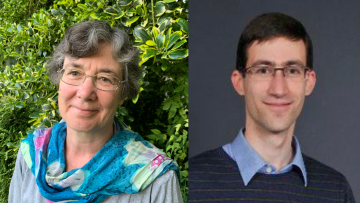15:00
Fixed points of group homomorphisms and the Post Correspondence Problem
Abstract
The Post Correspondence Problem (PCP) is a classical problem in computer science that can be stated as: is it decidable whether given two morphisms g and h between two free semigroups $A$ and $B$, there is any nontrivial $x$ in $A$ such that $g(x)=h(x)$? This question can be phrased in terms of equalisers, asked in the context of free groups, and expanded: if the `equaliser' of $g$ and $h$ is defined to be the subgroup consisting of all $x$ where $g(x)=h(x)$, it is natural to wonder not only whether the equaliser is trivial, but what its rank or basis might be.
While the PCP for semigroups is famously insoluble and acts as a source of undecidability in many areas of computer science, the PCP for free groups is open, as are the related questions about rank, basis, or further generalisations. In this talk I will give an overview of what is known about the PCP in hyperbolic groups, nilpotent groups and beyond (joint work with Alex Levine and Alan Logan).
15:00
Residual finiteness and actions on trees
Abstract
One of the more common ways to study a residually finite group (or its profinite completion) is via breaking it down into a graph of groups in some way. The descriptions of this theory generally found in the literature are highly algebraic and difficult to digest. I will present alternative, more geometric, definitions and perspectives on these theories based on properties of virtually free groups and their profinite completions.
15:00
Classifiability of crossed products by nonamenable groups
Abstract
The celebrated Kirchberg-Phillips classification theorem classifies so-called Kirchberg algebras by K-theory. Many examples of Kirchberg algebras can be constructed via the crossed product construction starting from a group action on a compact space. One might ask: When exactly does the crossed product construction produce a Kirchberg algebra? In joint work with Gardella, Geffen, and Naryshkin, we obtained a dynamical answer to this question for a large class of nonamenable groups which we call "groups with paradoxical towers". Our class includes many non-positively curved groups such as acylindrically hyperbolic groups and lattices in Lie groups. I will try to advertise our notion of paradoxical towers, outline how we use it, and pose some open questions.
15:00
From strong contraction to hyperbolicity
Abstract
For almost 10 years, it has been known that if a group contains a strongly contracting element, then it is acylindrically hyperbolic. Moreover, one can use the Projection Complex of Bestvina, Bromberg and Fujiwara to construct a hyperbolic space where said element acts WPD. For a long time, the following question remained unanswered: if Morse is equivalent to strongly contracting, does there exist a space where all generalized loxodromics act WPD? In this talk, I will present a construction of a hyperbolic space, that answers this question positively.
15:00
Coarse obstructions to cubulation
Abstract
Given a group $G$, finding a geometric action of $G$ on a CAT(0) cube complex can be used to say some rather strong things about $G$. Such actions are not always easy to find, however, which makes it useful to have sufficient conditions, both for existence and for non-existence. This talk concerns the latter: we shall see a coarse geometric obstruction to a group admitting a cocompact cubulation. Based on joint work with Zach Munro.
15:00
Measure doubling for small sets in SO(3,R).
Abstract
Let $SO(3,R)$ be the $3D$-rotation group equipped with the real-manifold topology and the normalized Haar measure $\mu$. Confirming a conjecture by Breuillard and Green, we show that if $A$ is an open subset of $SO(3,R)$ with sufficiently small measure, then $\mu(A^2) > 3.99 \mu(A)$. This is joint work with Chieu-Minh Tran (NUS) and Ruixiang Zhang (Berkeley).
15:00
Rank gradient in higher rank lattices
Abstract
In a recent work with Sam Mellick and Amanda Wilkens, we proved that higher rank semisimple Lie groups satisfy a generalization of Gaboriau fixed price property (originally defined for countable groups) to the setting of locally compact second countable groups. As one of the corollaries, under mild conditions, we can prove that the rank (minimal number of generators) or the first mod-p Betti number of a higher rank lattice grow sublinearly in the covolume. The proof relies on surprising geometric properties of Poisson-Voronoi tessellations in higher-rank symmetric spaces, which could be of independent interest.


